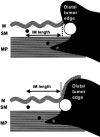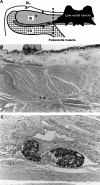Preoperative parameters expanding the indication of sphincter preserving surgery in patients with advanced low rectal cancer
- PMID: 14685098
- PMCID: PMC1356190
- DOI: 10.1097/01.sla.0000103070.13030.eb
Preoperative parameters expanding the indication of sphincter preserving surgery in patients with advanced low rectal cancer
Abstract
Objective: To clarify the preoperative parameters of the required distal margin that can be applied to the criteria of sphincter-preserving surgery in rectal cancer.
Summary background data: Although aggressive sphincter-preserving surgery, including intersphincteric resection, is beginning to be applied to low rectal tumors, unexpected distal cancer spread might undermine local control in patients undergoing such a procedure. The 'two-centimeter rule' of distal clearance is predominant at present, whereas preoperative criteria to determine the individual required distal margin have not yet been established.
Methods: First, by reviewing 556 rectal cancers, promising risk parameters of intramural distal spread (IM) were selected and, subsequently, such parameters were examined in regard to whether they could be evaluated preoperatively. Furthermore, 80 patients with lower rectal cancers located above the anal canal who were undergoing abdominoperineal resection were reviewed as to whether IM risk factors could be used as criteria to identify the low rectal cancer with or without anal canal involvement.
Results: IM was observed in 10.6% (IM >or= 10 mm: 2.3%) of the patients examined, and the incidence was higher in tumors with certain unfavorable histologic characteristics, including tumor "budding," in their submucosal region at the distal edge (24.4%) than in those with no such histology (5.3%). Regarding such unfavorable histology as IM risk factor, together with 3/4 or more annularity and type 3 gross appearance, IM rates were 3.3% (IM >or= 10 mm: 0.5%) in the no-risk group, 9.1% (IM >or= 10 mm: 1.7%) in the one-risk group, and 29.1% (IM >or= 10mm: 7.8%) in the multiple-risks group. These results were reproduced well even if such risk factors were evaluated endoscopically or histologically on preoperative biopsy specimens. Furthermore, no anal canal involvement was observed in 32 tumors without IM risk; however, microscopic cancer spread down to the anal canal, including that into outside of the internal sphincter muscle, was observed in 9.1% of tumors with one IM risk and in 26.7% of multiple-risk tumors.
Conclusions: The preoperative evaluation of particular parameters related to IM enabled the accurate selection of rectal cancer to which the one-centimeter rule of distal clearance can be applied. This could allow us to expand the indication of sphincter preservation for very low rectal cancer patients.
Figures




References
-
- Pryse-Phillips W. Follow-up study of patients with colostomies. Am J Surg. 1971;122:27–32. - PubMed
-
- Williams NS, Johnston D. The quality of life after rectal excision for low rectal cancer. Br J Surg. 1983;70:460–462. - PubMed
-
- Braun J, Treutner KH, Winkeltau G, et al. Results of intersphincteric resection of the rectum with direct coloanal anastomosis for rectal carcinoma. Am J Surg. 1992;163:407–412. - PubMed
-
- Teramoto T, Watanabe M, Kitajima M. Per Anum intersphincteric rectal dissection with direct coloanal anastomosis for lower rectal cancer. The ultimate sphincter-preserving operation. Dis Colon Rectum. 1997;40:S43–S47. - PubMed
Publication types
MeSH terms
LinkOut - more resources
Full Text Sources

